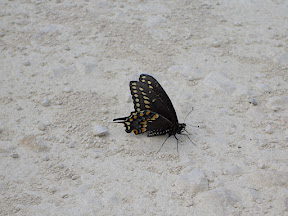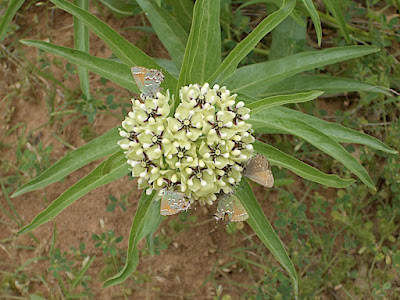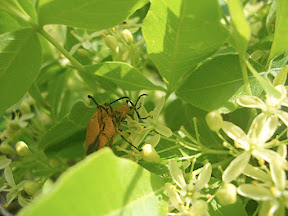The title says it all. Of the 122, 108 of these species were seen in the far NW corner of Missouri, the rest were seen en route. Anything in bold was exciting, unusual, unexpected or just plain novel. Our heaviest morning of diversity was undoubtedly the 2 hrs and 15 mins at
Squaw Creek National Wildlife Refuge that yielded 70 species (plus Empidonax flycatchers by the truckload and some distant "peeps" that didn't cooperate). Thanks to Pete Hosner for suggesting Squaw Creek!

Canada Goose (Branta canadensis)
Gadwall (Anas strepera)
Mallard (Anas platyrhynchos)
Blue-winged Teal (Anas discors)
Ruddy Duck (Oxyura jamaicensis)
Wild Turkey (Meleagris gallopavo)
Northern Bobwhite (Colinus virginianus)
Pied-billed Grebe (Podilymbus podiceps)
American White Pelican (Pelecanus erythrorhynchos)
Double-crested Cormorant (Phalacrocorax auritus)
Great Blue Heron (Ardea herodias)
Great Egret (Ardea alba)
Cattle Egret (Bubulcus ibis)
Black Vulture (Coragyps atratus)
Turkey Vulture (Cathartes aura)
Bald Eagle (Haliaeetus leucocephalus)
Northern Harrier (Circus cyaneus) Cooper's Hawk (Accipiter cooperii)
Red-shouldered Hawk (Buteo lineatus)
Broad-winged Hawk (Buteo platypterus)
Swainson's Hawk (Buteo swainsoni)
Red-tailed Hawk (Buteo jamaicensis)
Rough-legged Hawk (Buteo lagopus) American Kestrel (Falco sparverius)
Sora (Porzana carolina)
American Coot (Fulica americana)
Sandhill Crane (Grus canadensis)
Snowy Plover (Charadrius alexandrinus) Killdeer (Charadrius vociferus)
Spotted Sandpiper (Actitis macularius)
Solitary Sandpiper (Tringa solitaria)
Greater Yellowlegs (Tringa melanoleuca)
Upland Sandpiper (Bartramia longicauda)
Pectoral Sandpiper (Calidris melanotos)
Wilson's Snipe (Gallinago delicata)
Bonaparte's Gull (Chroicocephalus philadelphia)
Franklin's Gull (Leucophaeus pipixcan)
Black Tern (Chlidonias niger) Forster's Tern (Sterna forsteri)
Rock Pigeon (Columba livia)
Eurasian Collared-Dove (Streptopelia decaocto)
White-winged Dove (Zenaida asiatica)
Mourning Dove (Zenaida macroura)
Yellow-billed Cuckoo (Coccyzus americanus)
Barred Owl (Strix varia)
Chimney Swift (Chaetura pelagica)
Belted Kingfisher (Megaceryle alcyon)
Red-headed Woodpecker (Melanerpes erythrocephalus)Red-bellied Woodpecker (Melanerpes carolinus)
Downy Woodpecker (Picoides pubescens)
Hairy Woodpecker (Picoides villosus) Northern Flicker (Colaptes auratus)
Pileated Woodpecker (Dryocopus pileatus)
Willow Flycatcher (Empidonax traillii) Eastern Phoebe (Sayornis phoebe)
Great Crested Flycatcher (Myiarchus crinitus)
Western Kingbird (Tyrannus verticalis)
Eastern Kingbird (Tyrannus tyrannus)
Scissor-tailed Flycatcher (Tyrannus forficatus)
Loggerhead Shrike (Lanius ludovicianus)
Blue-headed Vireo (Vireo solitarius)
Red-eyed Vireo (Vireo olivaceus)
Blue Jay (Cyanocitta cristata)
American Crow (Corvus brachyrhynchos)
Horned Lark (Eremophila alpestris) Purple Martin (Progne subis)
Tree Swallow (Tachycineta bicolor)
Northern Rough-winged Swallow (Stelgidopteryx serripennis)
Bank Swallow (Riparia riparia) Cliff Swallow (Petrochelidon pyrrhonota)
Barn Swallow (Hirundo rustica)
Black-capped Chickadee (Poecile atricapillus)Tufted Titmouse (Baeolophus bicolor)
White-breasted Nuthatch (Sitta carolinensis) House Wren (Troglodytes aedon)
Marsh Wren (Cistothorus palustris)
Blue-gray Gnatcatcher (Polioptila caerulea)
Eastern Bluebird (Sialia sialis)
Swainson's Thrush (Catharus ustulatus) American Robin (Turdus migratorius)
Gray Catbird (Dumetella carolinensis) Northern Mockingbird (Mimus polyglottos)
Brown Thrasher (Toxostoma rufum) European Starling (Sturnus vulgaris)
Nashville Warbler (Vermivora ruficapilla)
Yellow Warbler (Dendroica petechia) Yellow-rumped Warbler (Dendroica coronata)
Palm Warbler (Dendroica palmarum)
Blackpoll Warbler (Dendroica striata) Black-and-white Warbler (Mniotilta varia)
American Redstart (Setophaga ruticilla)
Prothonotary Warbler (Protonotaria citrea)
Ovenbird (Seiurus aurocapilla)
Northern Waterthrush (Seiurus noveboracensis)
Louisiana Waterthrush (Seiurus motacilla) Common Yellowthroat (Geothlypis trichas)
Wilson's Warbler (Wilsonia pusilla)
Spotted Towhee (Pipilo maculatus) Chipping Sparrow (Spizella passerina)
Clay-colored Sparrow (Spizella pallida) Field Sparrow (Spizella pusilla)
Lark Sparrow (Chondestes grammacus)
Grasshopper Sparrow (Ammodramus savannarum) Song Sparrow (Melospiza melodia)
Lincoln's Sparrow (Melospiza lincolnii)
White-throated Sparrow (Zonotrichia albicollis)
Harris's Sparrow (Zonotrichia querula) White-crowned Sparrow (Zonotrichia leucophrys)
Northern Cardinal (Cardinalis cardinalis)
Rose-breasted Grosbeak (Pheucticus ludovicianus)Indigo Bunting (Passerina cyanea)
Bobolink (Dolichonyx oryzivorus) Red-winged Blackbird (Agelaius phoeniceus)
Eastern Meadowlark (Sturnella magna)
Common Grackle (Quiscalus quiscula)
Great-tailed Grackle (Quiscalus mexicanus)
Brown-headed Cowbird (Molothrus ater)
Orchard Oriole (Icterus spurius)
Baltimore Oriole (Icterus galbula) House Finch (Carpodacus mexicanus)
American Goldfinch (Carduelis tristis)
House Sparrow (Passer domesticus)
...not bad for only 7 cumulative hrs of intentional birding! Methinks the 24+ hrs of driving is what did it, though.
Froggi, this photo is for you:





































































